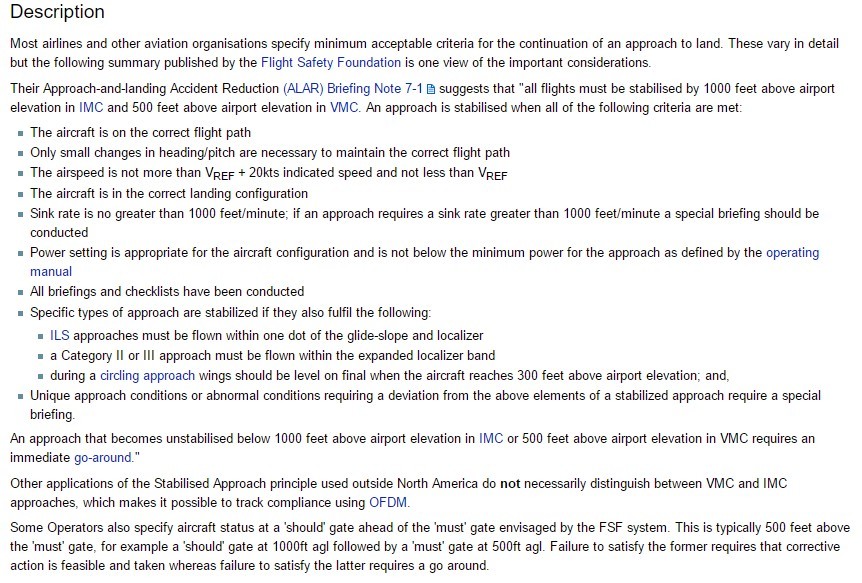Medewok, these wrap it up pretty well:
Here’s a video from two days ago, EDNX Oberschleissheim. Windy day, but I had time to adjust pitch, power and speed on my ‘virtual’ glidepath. That’s what I mean by stabilised.
You touched down to the left. As an instructor once told me: “there is no acceptable reason not to touch down on the centerline; it is a matter of concentration”.
EuroFlyer wrote:
Windy day, but I had time to adjust pitch, power and speed on my ‘virtual’ glidepath. That’s what I mean by stabilised.
That’s an ordinary “by the book VFR final”, and has nothing to do with the stabilized approach concept at all. This is from Skybrary:

OK, if we can’t resist the urge to squeeze the stabilized approach terminology into light GA (because it makes us feel somewhat cooler or whatever), then we are left with:
An approach is stabilised when all of the following criteria are met:
All the others are meaningless. “Correct flight path” is either obvious or irrelevant. “only small changes in heading/pitch” – irrelevant for light GA, and so on. When we look at what’s left, it doesn’t make all that much sense, because neither the landing configuration nor the briefings and checklists can become “unstabilised”. In the end, what we are left with, and what makes sense (what we all learn) is:
Before (short) final, preferably on down wing leg, or on long final, be sure the following is done:
In a glider (which I first flew in), a go around is no option, but the rest is the same. The point is that the the two checks shall be done well before any questions of a go around comes up. It shall be done before entering (short) final, preferably on down wind leg. The question of go around itself, is not a procedural thing, but purely a question if you can safely bring the aircraft to a full stop from a technical point of view.
Rwy20, I’ll have to live with that terrible, terrible mistake for the rest of my life. The plane still flies, and I could still walk away from it, so… ;)))
Le Sving, I don’t understand your point, sorry…
>>>>All the others are meaningless. “Correct flight path” is either obvious or irrelevant. “only small changes in heading/pitch” – irrelevant for light GA, and so on. When we look at what’s left, it doesn’t make all that much sense, because neither the landing configuration nor the briefings and checklists can become “unstabilised”.<<<
The skybrary text you copied makes a lot of sense to me. Why do you say it is it irrelevant for light GA ?
Somewhat off topic now but the second of the top three videos sums up very well what most instructors and pilots think a stable approach means in ga. Whatever you call it, or however you define it, it just makes good sense and i dont think is much to do with pretending ga is like flying cat.
While I don’t care about “CAT Terminology” or coolness (for that I have my sunglasses :-), a well trimmed airplane, constant (and as low as possible) speed and a constant angle to the touchdown point are musts. VFR I always use the short field speed of 77 KIAS and for each 100 lb below MTOM i fly 1 KIAS slower. This way I have no problems landing the SR22 on Helgoland (440 m), which is impossible if you don’t have good speed management.
Feels to me like some people need steep turns before landing to look cool ;-)
Fuji_Abound wrote:
Somewhat off topic now but the second of the top three videos sums up very well what most instructors and pilots think a stable approach means in ga.
I agree with all they’re saying, especially the guy at 4:39 who says “good landings should require little drama, you know, there’s no big heroics and there’s no great timing”. Note though how they never use the term “stabilized approach” or even “stable approach” once in 5 minutes. That avoids confusion, because you’re not trying to apply jet flying concepts to piston aircraft (it’s not so much about GA vs. CAT but piston powered vs. jet). If not, I’d have had to abandon every low circuit that I fly in the Piper Cub and would have eventually run out of fuel. 
Being on the centerline from final until touch down has become one of the criteria that I apply to judge my approach and landing.
Rwy20 wrote:
Note though how they never use the term “stabilized approach” or even “stable approach” once in 5 minutes.
No, they don’t have to. Because at 0:20 the whole video is called “stabilized approaches”.
The concept of a stabilised approach is much more important in Jets where speed control is much trickier, whilst at the same time needing to be more precise to achieve performance.
All propeller aircraft are much easier in that regard and it’s something that’s overdone and somewhat inappropriate for light aircraft. However, flying an approach is easier if you get it all set up and don’t fiddle about with power, speed, etc…. exactly as others are saying above.